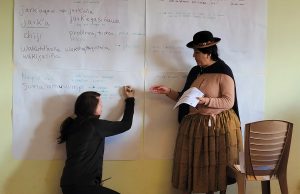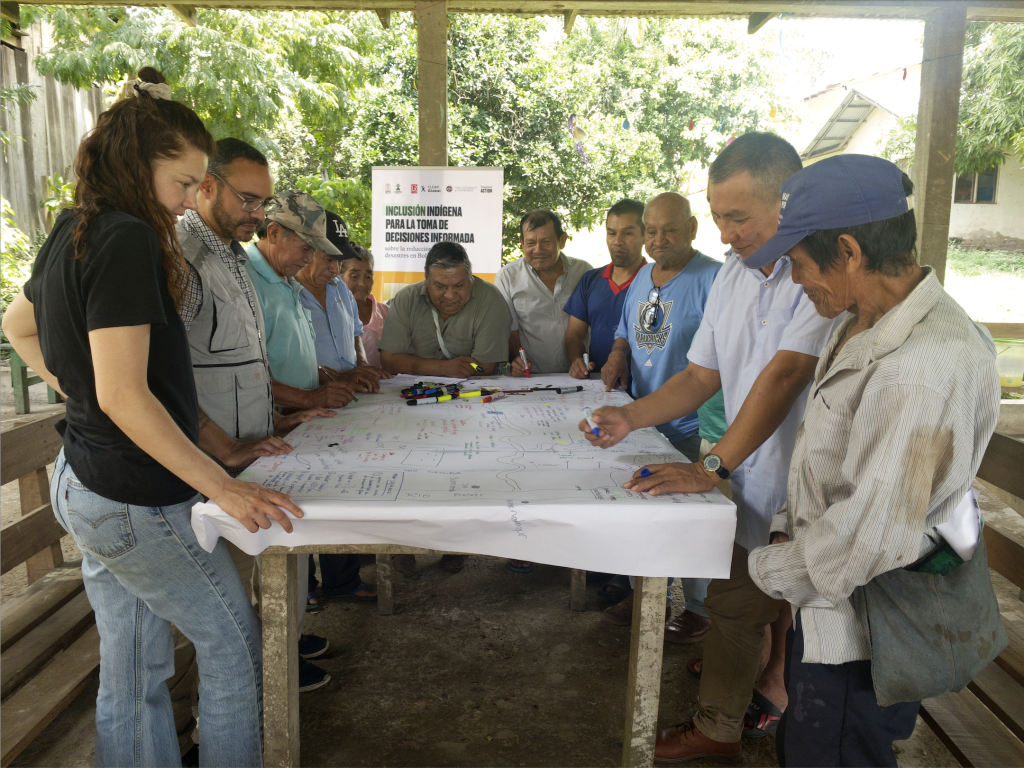Languages are an essential part of culture and the shaping of groups, peoples and nations. They allow us to name the world, to get to know it and recognize it from our understanding, memory and collective experience. Language cuts across history, culture, socio-political and environmental context and their transformations over time.
Language cuts across history, culture, socio-political and environmental context and their transformations over time. Within the framework of the Indigenous inclusion for informed disaster risk reduction decision-making project, CLEAR Global and Practical Action conducted a socio-linguistic analysis with women and men from the Aymara and Tacana Indigenous nations in Bolivia to identify how they understand and express different concepts related to risk management based on their own experience and representations.
Indigenous communities in Latin America and the Caribbean are among the most vulnerable when facing climate-related disasters, but they remain largely excluded from formal decision-making processes. About 40% of the region’s rural population is Indigenous, but their participation often has no place in data collection processes. Their traditional knowledge, built up over generations of direct experience with their environments, is frequently overlooked and not used to inform subsequent policies and plans. This exclusion not only further marginalizes these groups, but also weakens disaster preparedness strategies by ignoring valuable territory-based knowledge.
An additional issue is the lack of accessible information and the absence of training. Early warning systems and disaster-related guidance are often overly technical or not available in local languages, leaving many people unprepared in times of crisis. Without adequate training on how to interpret and respond to warnings, and without integrating local knowledge into official systems, Indigenous populations continue to face disproportionate risks in the face of extreme weather events and climate change.
“We want to better understand the needs and use of Indigenous languages in risk management contexts, such as the broadcast of alerts, risk bulletins, and other information in the area,” explains Leon Lizon (Practical Action).
Clarifying the meaning of concepts


Nimepishihue in Tacana, asxartawi in Aymara, or vulnerabilidad in Spanish, was one of the concepts translated by experts for validation by representatives of both Indigenous nations.
Aymara and Tacana representatives in the communities of Corpa (Jesús de Machaca) and Tumupasa (San Buenaventura) took part in the consultation of about 50 terms related to risk management. They used participatory methodologies with the support of Aymara and Tacana interpreters to facilitate a fluid dialogue and to be able to understand and analyze the use and usefulness of these words in their language, or finally to adapt them for a better understanding and closeness to their reality.
“We have organized these workshops in order to better understand the role that language and communication play in early warning systems and practices in communities affected by disasters, which are often triggered by climate change.” Ingrid Gercama (consultant at CLEAR Global).
As part of the project, various activities were developed, such as interviews with different stakeholders, discussion groups differentiated by age and gender. One of the aims of the project was to create a glossary of disaster-related terms. To ensure that the translations were clear and understandable, community members tested and discussed the terms, and local language experts provided input.
The glossary includes about 50 key disaster terms and uses Bolivian law, an international risk survey and other reference materials as sources. These terms were translated from Spanish and English into Aymara and Tacana, along with their definitions.
The need to accelerate actions for gender equity and social inclusion
“During the socio-linguistic analysis work, it was possible to observe the risk management needs of the communities and their high vulnerability,” says Leon Lizon.
The weather information gap for climate change adaptation and preparedness for adverse events is widest for Indigenous populations. The alerts issued by national entities rarely reach these communities and when they do, they are diluted among the groups with better access to this valuable information. Natural indicators are still an option based on their agricultural practices and culture, but these are no longer reliable because of constant climate change.
Bioindicators (cues from nature such as animal behavior and changes in vegetation) have traditionally been used by farmers in these communities to predict the weather and plan their crops. However, they are becoming less reliable due to the lack of predictability brought about by climate change.
Erratic weather patterns are altering these traditional cues, such as birds building nests at unusual heights or the Andean fox no longer howling when rain is expected. Farmers who rely on these indicators have sometimes made decisions regarding planting times that have turned out to be wrong, resulting in crop losses.
While these bioindicators still have cultural and practical value, scientists stress that they need to be complemented with empirical data to confirm their accuracy. Experts suggest combining traditional knowledge with modern weather data to develop more effective disaster risk reduction strategies.
Understanding risk is one of the pillars of risk management and early warning systems. During the development of the workshops, the participants demonstrated their knowledge and experience of threats and vulnerabilities, as well as their practices for information and risk reduction in their communities. Some of these practices focus on warning systems based on natural indicators, agricultural practices to protect crops, a traditional communal organization and the naming of these concepts.


Significant gaps were also evident in risk management, access to climate information and alerts, as well as in the understanding of associated terms. Our team perceived that these gaps are even more pronounced in older women and adults. This could be due to the level of schooling, access to information on risk management, practical prioritization of other activities, access to and understanding of alerts, communications, etc.
The basis of risk prevention work is based on access to information. If communication routes are optimized and designed with an inclusive approach, it is possible to deal with different threats more efficiently.
“It is important that communication material about early warning systems is in a language that people understand. For example, in Corpa it would be in Aymara and Spanish. Young people speak Spanish more often, so there is a need for information in both languages. In addition, radio groups and WhatsApp have real potential to be used for community-centered early warning,” says Ingrid.
“What we want is for communities to be able to articulate with national law and at some point be part of decision-making from their own experiences and their own culture,” says Diego Chirinos (Practical Action).
What have we learned from these communities?
We have learned that language is much more than a communication tool. It is a fundamental pillar for inclusive and effective risk management in Indigenous communities. It is essential that initiatives aimed at creating efficient risk management systems take into account the linguistic diversity of the communities where they are to be implemented, as well as the active participation of those communities. Therefore, it is not enough to translate. Language and communication must be adapted to the characteristics and needs of each group, ideally considering the different ranges of age, gender, economic capacity and access to technology. In isolated areas, where connectivity is limited, community radio becomes essential.
For Tacanas and Aymaras, language is used predominantly orally. It is important to use audiovisual formats to be able to effectively reach these populations and promote education as a construction space for risk management.
In addition, we must engage young leaders of all genders to ensure the continuity of traditional risk management practices in conjunction with modern warning and communication systems.
In order for Indigenous communities to make informed decisions, they need to strengthen their knowledge of risk management. For the concepts and technical terms of national officials and agencies to be understood, it is crucial to establish alliances with language and culture institutes, as well as to work together with national stakeholders such as Viceministerio de Defensa Civil (VIDECI) and Plataforma De Naciones Y Pueblos Indígenas Originarios Campesinas de Lucha Contra el Cambio Climático (PILCCC)
It is still a challenge, but we must accelerate the actions that allow us to build communities, peoples and nations that are more resilient and prepared to face the challenges of climate change.
By: Mónica Cuba and José Durán (Practical Action), and Clara Sanchiz (CLEAR Global).